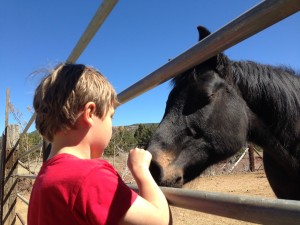The other day I was working on a horse who began to swish his tail when I attempted to lift a hind leg. Obviously, this was painful for him, so he was letting me know in the way that he knows how, without kicking or biting me.
Horses are masters of the subtle – in movement, glances, twitches, swishes – knowing they can impact their world of horses with these small gestures. They would hope they could do so with humans too.
But people are often not so savvy and have to learn these movements – the swish of the tail, the curl of the nostrils, the way they move their bodies away from us or into us. If we haven’t been raised around horses or spent a lot of time just watching them with each other, we can easily miss these subtle signs.
Horses are also very sensitive to touch. The handler who thinks by petting the horse roughly, slapping the horse’s neck, rubbing it hard between the eyes, they are doing a good thing, is not paying attention to the horse. Very few horses enjoy this. They may tolerate it, figuring it will soon be over.
The horse is so sensitive that he can feel a fly landing on his fur. This animal is not a dog, who wants endless petting and its fur rubbed all sorts of ways. I’m not even sure dogs even like it that much, but it may be the avenue they know to get attention from humans.
Humans have the tendency to approach animals on their own terms, without questioning whether the animal really likes it or not. When I encounter a horse who doesn’t like my touch or handling, I then try to find another way to engage him.
 In the case of the horse I mentioned above, I found ways to just hold areas to bring comfort. Bring tissue around the painful spot. I can also work with my hands off the body, just as horses communicate this way with one another.
In the case of the horse I mentioned above, I found ways to just hold areas to bring comfort. Bring tissue around the painful spot. I can also work with my hands off the body, just as horses communicate this way with one another.
The same is true in training. We train in human terms, with our goals in mind. My mare Jazzie makes that very clear when she sighs deeply at some of the things I ask her to do. It’s sort of like, ‘Yeah, I can do that but it doesn’t interest me.’ There are things I need her to learn that she probably doesn’t care whether she learns or not. The best I can do there is make them fun and interesting. I also need to stop the activity before she gets bored and frazzled, again, keeping it interesting and keeping her curiosity alive for the next time we work together.
Being a human, often I want to go back to that same activity the next day to see how much progress we can get. I get so excited by progress! But I find it’s better to change it up, introduce some other activity that involves different skills.
If we are focused on our goals, then we may miss the subtle signs, the yawn, the eye blink,  the curl of the nostrils. Our goals are still important because the horse may need treatment, training or other intervention, but it’s important to have the entire picture of what’s going on, also from the horse’s perspective.
the curl of the nostrils. Our goals are still important because the horse may need treatment, training or other intervention, but it’s important to have the entire picture of what’s going on, also from the horse’s perspective.
Learning touch and body language is best learned from the horse because they don’t ever lie. You may not like what they say with their bodies or their response to a touch, but it is an honest response. There is no guile in that response. Even a horse who is trying to please will make that clear, if you take the time to notice.
(c) Susan Smith, Horses at Liberty Foundation Training, Equine Body Balance (TM)
Please see my
Events for information on upcoming clinics and workshops.




The forum is a brighter place thanks to your posts. Thanks!